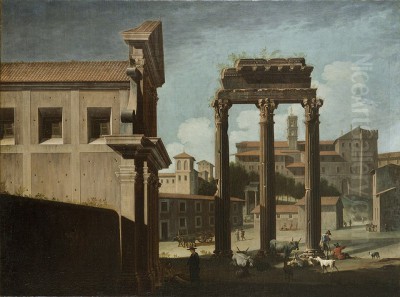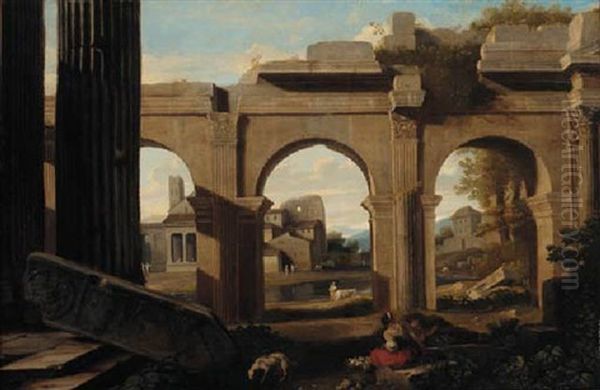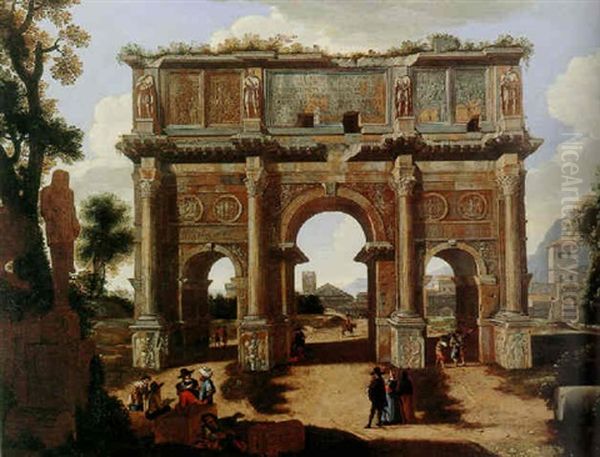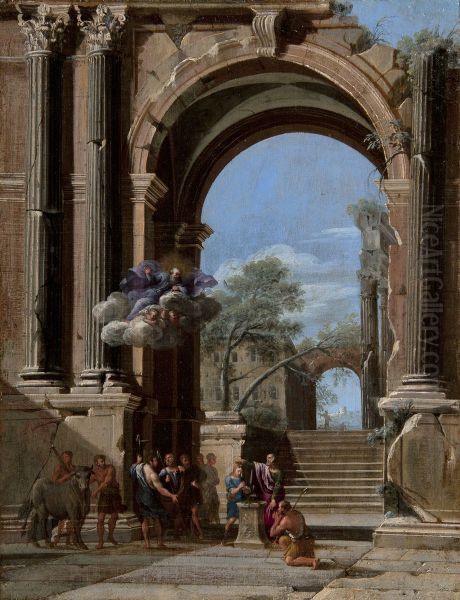
Niccolò Codazzi, a significant figure in the landscape of 17th-century Italian Baroque art, carved a distinct niche for himself as a painter of architectural views, or vedute, and particularly, imaginative architectural compositions known as capricci. Born in Naples in 1642 and passing away in Genoa in 1693, his life and career spanned a period of rich artistic ferment and evolving tastes. Son of the equally renowned architectural painter Viviano Codazzi, Niccolò inherited a profound understanding of perspective, light, and classical form, which he skillfully blended with his own inventive spirit. His works, often characterized by grandiose classical ruins, bustling contemporary figures, and a masterful play of light and shadow, offer a captivating window into the Baroque fascination with antiquity, theatricality, and the picturesque.
Early Life and Formative Influences
Niccolò Codazzi’s artistic journey began under the direct influence of his father, Viviano Codazzi (c. 1604 – 1670). Viviano, often referred to as Viviano Codagora, was himself a pioneering figure in the genre of architectural painting. He was originally from Bergamo but established his reputation primarily in Naples and Rome. Viviano was celebrated for his realistic depictions of classical ruins and contemporary urban scenes, often collaborating with figure painters like Domenico Gargiulo (known as Micco Spadaro) and Michelangelo Cerquozzi (known as Michelangelo delle Battaglie or Michelangelo delle Bambocciate). Growing up in this environment, Niccolò would have been immersed in discussions of perspective, classical orders, and the techniques of rendering stone and light from a very young age.
The elder Codazzi’s workshop was a crucible of artistic exchange. Viviano's collaborations with figures like Cerquozzi, a prominent member of the Bamboccianti (a group of predominantly Dutch and Flemish genre painters active in Rome who depicted everyday life), meant that young Niccolò was exposed to diverse artistic currents. The Bamboccianti, led by figures such as Pieter van Laer (nicknamed "Il Bamboccio," meaning "ugly doll" or "puppet"), specialized in small-scale paintings of Roman street life, peasants, and festivities, often set against a backdrop of ancient ruins or contemporary Roman architecture. This fusion of everyday life with monumental settings was a hallmark that Viviano often incorporated, and Niccolò would later adapt.

Following his father's death in 1670, Niccolò's path led him to France. It is documented that he spent time in Paris, a significant artistic center that was then under the cultural ascendancy of Louis XIV. This period abroad would have exposed him to different artistic sensibilities, including the more formal classicism prevalent in French art under the influence of painters like Nicolas Poussin and Claude Lorrain, though Lorrain himself spent most of his career in Italy and was a master of idealized landscapes with classical ruins. The experience in Paris, and potential interactions with French artists, likely broadened Niccolò's artistic vocabulary and perhaps refined his compositional strategies. He is known to have collaborated with French artists, most notably René-Antoine Houasse, on decorative projects.
The Art of the Capriccio and Veduta
Niccolò Codazzi’s oeuvre is primarily defined by two intertwined genres: the veduta (view painting) and the capriccio (architectural fantasy). While a veduta aims for a relatively accurate depiction of a specific place, a capriccio allows the artist far greater freedom, combining real and imagined architectural elements to create an idealized or picturesque scene. Niccolò excelled in the latter, though his works often blur the lines between the two.
His capricci are not mere flights of fancy but are deeply rooted in a thorough understanding of classical architecture. He drew upon the rich visual lexicon of Roman ruins – triumphal arches, colonnades, crumbling temples, and grand basilicas – rearranging and reinterpreting them to evoke a sense of timeless grandeur and romantic decay. These architectural elements were often juxtaposed with lively staffage figures (small human and animal figures added to a scene), which provided scale, narrative interest, and a connection to contemporary life. The figures in his paintings, sometimes painted by collaborators, animate these monumental settings, engaging in everyday activities, religious ceremonies, or dramatic events.
A key characteristic of Niccolò’s style is his sophisticated handling of light and shadow (chiaroscuro). He used light not just to model form but also to create atmosphere and direct the viewer’s eye. Sunlight often streams through arches or illuminates specific sections of a ruin, casting deep shadows that enhance the sense of depth and drama. This dramatic illumination is a hallmark of Baroque art, seen in the works of Caravaggio and his followers, though applied by Codazzi to the realm of architectural painting. His perspective is typically precise, creating convincing illusions of space that draw the viewer into his imagined worlds. This mastery of perspective was a legacy from his father but also a skill highly valued in an era that saw the development of complex stage designs and illusionistic ceiling paintings (quadratura), a field in which artists like Agostino Tassi (a teacher of Claude Lorrain) and later Andrea Pozzo excelled.
Major Works and Artistic Themes

Several key works illustrate Niccolò Codazzi’s artistic prowess and thematic concerns. While a definitive catalogue raisonné can be complex for artists of this period due to workshop practices and attribution challenges, certain paintings are widely accepted as representative of his style.
One such example is the _Architectural Capriccio with a Sacrificial Scene_. This painting showcases many of Codazzi’s signature elements. A grand, imaginative architectural setting, inspired by classical Greek and Roman forms, dominates the canvas. Colonnades, porticoes, and courtyards recede into the distance, creating a dynamic spatial rhythm. The play of light and shadow is particularly effective, highlighting the textures of stone and the depth of the architectural vistas. Within this monumental framework, a sacrificial scene unfolds, with figures in vaguely antique or exotic attire. The inclusion of such a narrative element, often with religious or mythological undertones, was common in capricci, adding a layer of intellectual or emotional engagement beyond the purely architectural.
_Roman Ruins_ (various versions exist) is another theme central to his work. These paintings typically depict crumbling classical structures – perhaps a section of the Roman Forum, the Colosseum, or imaginary amalgamations of various ruins. Often, these scenes are populated by small figures: travelers resting, artists sketching, or locals going about their daily lives. These figures serve to emphasize the scale of the ruins and to create a poignant contrast between the enduring grandeur of the past and the transience of human existence. The romantic appeal of ruins, a theme that would become even more prominent in later centuries with artists like Giovanni Battista Piranesi and Hubert Robert, was already well-established in Codazzi’s time.
The _Basilica of Constantine_ (more accurately, the Basilica of Maxentius and Constantine) in Rome was a popular subject for artists, and Codazzi produced his own interpretations. These works demonstrate his ability to capture the immense scale and structural ingenuity of Roman architecture. His depictions often focus on the surviving massive barrel vaults and coffered ceilings, using perspective and light to convey their awe-inspiring presence. Again, staffage figures would typically be included, perhaps scholars examining the structure or common folk seeking shelter, grounding the ancient monument in a relatable human context.

Other notable works attributed to him or his circle include paintings like _Banquet in a Palace Garden_, _Arch of Constantine_, and _Arch of Titus_. These titles suggest a continued engagement with both grand palatial settings and specific, recognizable Roman landmarks, often treated with a degree of artistic license characteristic of the capriccio. His paintings of palace gardens combine architectural elements with formal landscapes, reflecting the Baroque interest in elaborate garden design as an extension of architectural space.
Collaborations and Contemporaries
Collaboration was a common practice in the 17th century, particularly for specialized painters. Architectural specialists like the Codazzis often teamed up with figure painters (figuristi) to complete their compositions. Niccolò continued this tradition. As mentioned, his father Viviano frequently worked with Micco Spadaro and Michelangelo Cerquozzi. Niccolò, in turn, is known to have collaborated with various artists.
His time in France saw him work with René-Antoine Houasse (c. 1645–1710), a French painter who was a pupil of Charles Le Brun and worked extensively on decorative schemes at Versailles. Codazzi and Houasse are recorded as having produced four large architectural paintings for the Queen's Staircase (Escalier de la Reine) at the Palace of Versailles. This prestigious commission underscores Niccolò’s standing and his ability to adapt his style to the grand decorative programs favored by the French court.
In Genoa, where he spent the latter part of his life, Niccolò is believed to have collaborated with members of the Piola family, a prominent dynasty of Genoese painters. Domenico Piola (1627–1703) was a leading figure in Genoese art, known for his prolific output of frescoes and oil paintings in a vibrant Baroque style. Such collaborations would have involved Codazzi painting the architectural settings, with Piola or his workshop adding the figures.
Beyond direct collaborators, Niccolò Codazzi’s work existed within a rich ecosystem of contemporary artists exploring similar themes. In Rome, the tradition of vedute and capricci was flourishing. Artists like Giovanni Ghisolfi (1623–1683) were also known for their architectural fantasies, often with a strong classical flavor. The Dutch Italianates, such as Jan Both, Nicolaes Berchem, and Karel Dujardin, while often focusing more on pastoral landscapes, frequently incorporated classical ruins into their compositions, bathed in a warm, Italian light that influenced many.
The towering figure of Claude Lorrain (1600–1682), though primarily a landscape painter, created idealized scenes that masterfully integrated classical architecture and mythological or biblical narratives. His poetic vision and exquisite handling of light set a standard for landscape painting that resonated for centuries. While Codazzi’s focus was more squarely on the architecture itself, the atmospheric qualities and idealized classicism of Lorrain’s work were part of the broader artistic environment. Similarly, Herman van Swanevelt (c. 1603–1655), another Dutch Italianate active in Rome, produced landscapes with ruins that contributed to this popular genre.
The legacy of earlier architectural painters like Alessandro Salucci (c. 1590 – c. 1655-60), who also specialized in imaginative harbor scenes and classical ruins, often with figures by other artists like Jan Miel or the aforementioned Michelangelo Cerquozzi, provided a foundation upon which Viviano and subsequently Niccolò built. The market for such paintings was robust, fueled by aristocratic patrons, church officials, and increasingly, by wealthy travelers on the Grand Tour who desired sophisticated souvenirs of their Italian sojourn.
The Codazzi Artistic Lineage
The father-son dynamic between Viviano and Niccolò Codazzi is central to understanding Niccolò’s development. Viviano was a master of a more straightforward, realistic architectural perspective, often depicting recognizable locations with clarity and precision. His works, while sometimes incorporating fantastical elements, leaned more towards the veduta esatta (accurate view). He established a strong reputation for this type of painting, which was highly sought after.
Niccolò inherited his father’s technical skill in perspective and architectural rendering but appears to have pushed further into the realm of the capriccio. His compositions are often more overtly imaginative, more dramatic in their use of light, and perhaps more theatrical in their overall effect. While Viviano laid the groundwork, Niccolò elaborated upon it, infusing his scenes with a heightened sense of Baroque dynamism and fantasy. This evolution can be seen as a natural progression, reflecting the broader shifts in artistic taste during the 17th century towards more complex and emotionally charged compositions.
The Codazzi name became synonymous with high-quality architectural painting. Their influence, combined with that of other specialists in the genre, helped to solidify architectural painting as a respected and popular field. Later artists, such as Giovanni Paolo Panini (1691–1765) in the 18th century, would take the capriccio and veduta to new heights of complexity and popularity, building on the foundations laid by painters like the Codazzis. Panini, in particular, became famous for his views of Roman ruins and his imaginative "gallery paintings" that depicted collections of famous Roman sights all within one canvas.
Historical and Cultural Context: Baroque Italy
Niccolò Codazzi worked during the high Baroque period in Italy, an era of profound artistic, religious, and intellectual energy. The Counter-Reformation continued to shape religious art, but secular patronage was also expanding, leading to a diversification of genres. Rome, where both Codazzis spent significant time, was the undisputed center of the art world, attracting artists from all over Europe. The papacy and powerful Roman families were major patrons, commissioning vast decorative schemes for churches and palaces.
The fascination with classical antiquity, which had been a driving force since the Renaissance, remained potent. Archaeological discoveries, though not yet systematic, continually brought new aspects of the Roman past to light. Artists studied ancient sculptures, architectural fragments, and texts, incorporating classical motifs and ideals into their work. For painters like Codazzi, the ruins of ancient Rome were not just picturesque backdrops but potent symbols of history, empire, and the passage of time. They evoked a sense of nostalgia for a glorious past but also served as a reminder of the impermanence of human endeavors – a common Baroque theme of vanitas.
The development of perspective during the Renaissance had revolutionized painting, and Baroque artists continued to explore its expressive possibilities. The ability to create convincing illusions of depth was crucial for architectural painters, as well as for those creating large-scale frescoes and theatrical stage designs. The concept of quadratura, or illusionistic architectural painting that appeared to extend real architectural spaces, was highly developed, and the principles underlying it were closely related to the skills required for easel paintings of architectural views.
The market for art was also evolving. Beyond large-scale commissions, there was a growing demand for easel paintings that could be displayed in private homes. Genres like landscape, still life, and genre scenes (including the Bamboccianti's depictions of everyday life) gained popularity. Architectural paintings, with their blend of classical learning, technical skill, and picturesque appeal, found a ready market among educated and wealthy collectors. The Grand Tour, an educational rite of passage for young European noblemen, further fueled this demand, as travelers sought mementos of the classical sites they had visited. Codazzi's works, with their evocative depictions of Roman grandeur, would have been highly desirable in this context.
Legacy and Conclusion
Niccolò Codazzi’s career, though perhaps overshadowed in modern scholarship by some of his more famous contemporaries, represents an important contribution to Baroque art. He successfully navigated the artistic currents of his time, building upon his father’s legacy while developing his own distinctive voice within the specialized genre of architectural painting. His ability to blend meticulous architectural rendering with imaginative composition and dramatic lighting resulted in works that are both intellectually engaging and visually captivating.
His collaborations, particularly with French artists for Versailles, indicate the international reach of his reputation. His activity in major Italian artistic centers like Naples, Rome, and Genoa placed him at the heart of Baroque artistic production. The enduring appeal of his capricci lies in their power to transport the viewer to an idealized classical world, one filled with monumental beauty, romantic decay, and the echoes of a distant past.
While detailed biographical information about Niccolò Codazzi can sometimes be elusive, his paintings speak eloquently of his skill and vision. They are a testament to the Baroque era's fascination with perspective, illusion, and the enduring allure of classical antiquity. His works are found in various museums and private collections, allowing contemporary audiences to appreciate his mastery of the architectural fantasy. He, along with his father Viviano, played a crucial role in establishing and popularizing a genre that would continue to inspire artists for generations, leaving an indelible mark on the history of European art. His paintings remind us of a time when the ruins of the past were not just archaeological sites but vibrant sources of artistic inspiration, fueling imaginations and shaping a unique vision of history and beauty.